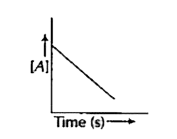The chemistry of corrosion of iron is essentially an electrochemical phenomenon. Explain the reactions occurring during the corrosion of iron in the atmosphere. Suggest two materials other than hydrogen that can be used as fuels in fuel cells.
The molar conductivity of 0.025 mol L−1, methanoic acid is 46.1scm2mol−1. Calculate its degree of dissociation and dissociation constant.Solution in Odia
α=0.1140
Ka=3.67×10−4mol L−1
Given, λ∘(H+)=349.6scm2mol−1
λ∘(HCOO−)=54.6scm2mol−1
Topper's Solved these Questions
- SAMPLE PAPER 5 BOOK - ARIHANT PUBLICATIONCHAPTER - SAMPLE PAPER 5 EXERCISE - GROUP B
24 Videos
- SAMPLE PAPER 4 BOOK - ARIHANT PUBLICATIONCHAPTER - SAMPLE PAPER 4 EXERCISE - GROUP C
7 Videos
- SURFACE CHEMISTRYBOOK - ARIHANT PUBLICATIONCHAPTER - SURFACE CHEMISTRYEXERCISE - CHAPTER PRACTICE ( LONG ANSWER TYPE QUESTIONS)
1 Videos
Similar Questions
What is meant by denaturation of proteins?
View SolutionConsider the reaction, Ak−−→P. The change in the concentration of A with time is shown in the following plot:

(a) Derive the expression for the time required for the completion of the reaction.
(b) Predict the order of the reaction.
View SolutionWrite any two methods for preparation of colloid .
View SolutionThe molar conductivity of 0.025molL−1 methanoic acid is 46.1Scm2mol−1. Its degree of dissociation (α) and dissociation constant. Given λ∘(H+)=349.6Scm−1 and λ∘(HCOO−)=54.6Scm2mol−1.
View SolutionThe chemistry of corrosion of iron is essentially an electrochemical phenomenon. Explain the reactio:rs occurring during the corrosion of iron in the atmosphere.
View SolutionThe molar conductivity of 0.025 mol L^(-1) methanoic acid is 46.1 S cm^(2)mol^(-1) . Calculate its degree of dissociation and dissociation constant. Given lamda^(@)(H^(+))=349.6" S "cm^(2)mol^(-1) and lamda^(@)(HCO O^(-))=54.6" S "cm^(2)mol^(-1) .
View SolutionCorrosion is essentially an electrochemical phenomenon. Explain the reactions occurring during corrosion of iron kept in an open atmosphere.
View SolutionThe molar conductivity of 0.025 M methanoic acid (HCOOH) is 46.15 S cm2mol−1. Calculate its degree of dissociation and dissociation constant. Given λ∘(H+)=349.6 S cm2mol−1 and λ∘(HCOO−)=54.6 S cm2mol−1.
View Solution0.025molL−1 मेथेनोइक अम्ल की चालकता 46.1Scm2mol−1 है। इसकी वियोजन मात्रा एवं वियोजन स्थिरांक का परिकलन कीजिए। दिया गया है कि Λ0H+=349.6Scm2mol−1एवंΛ0HCOO−=54.6Scm2mol−1
View SolutionThe molar conductivity of 0.024 "mol" L^(-1) methanoic acid is 46.1 S cm^(-2)"mol"^(-1) . Calculate its degree of dissociation and dissociation constant. Given lambda^(0)(H^(+) = 349.6 S cm^(2) mol^(-1) and lambda^(0)(HCOO^(-)) = 54.6 S cm^(2) mol^(-1) .
View SolutionThe molar conductivity of 0.025 mol L−1 methanoic acid is 46.1 S cm2molL−1 . Calculate its degree of dissociation and dissociation constant. Given λ∘(H+)=349.6Scm2mol−1 and λ∘(HCOO−)=54.6Scm2mol−1.
View SolutionThe chemistry of corrosion of iron is essentially an electrochemical phenomenon. Explain the reactions occurring during the corrosion of iron in the atmosphere.
View SolutionThe chemistry of corrosion of iron is essentially an electrochemical phenomenon. Explain the reactio:rs occurring during the corrosion of iron in the atmosphere.
View SolutionThe molar conductivity of 0.025 mol L^(-1) methanoic acid is 46.1 S cm^(2) mol^(-1) . Its degree of dissociation (alpha) and dissociation constant. Given lambda^(@)(H^(+))=349.6 S cm^(-1) and lambda^(@)(HCOO^(-)) = 54.6 S cm^(2) mol^(-1) .
View SolutionThe molar conductivity of 0.025 mol L−1 methanoic acid is 46.1 S cm2mol−1. Calculate its degree of dissociation and dissociation constant. Given λ∘H+=349.6S cm2 mole−1andλ∘(HCOO−)=54.6 S cm2mol−1.
View SolutionThe molar conductivity of 0.025 mol L^-1 methanoic acid is 46.1 S cm^2 mol^-1 . Calculate its degree of dissociation and dissociation constant. Given lambda^@(H^+) = 349.6 S cm^2 mol^-1 abd lamda^@(HCOO-) = 54.6 S cm^2 mol .
View Solution
